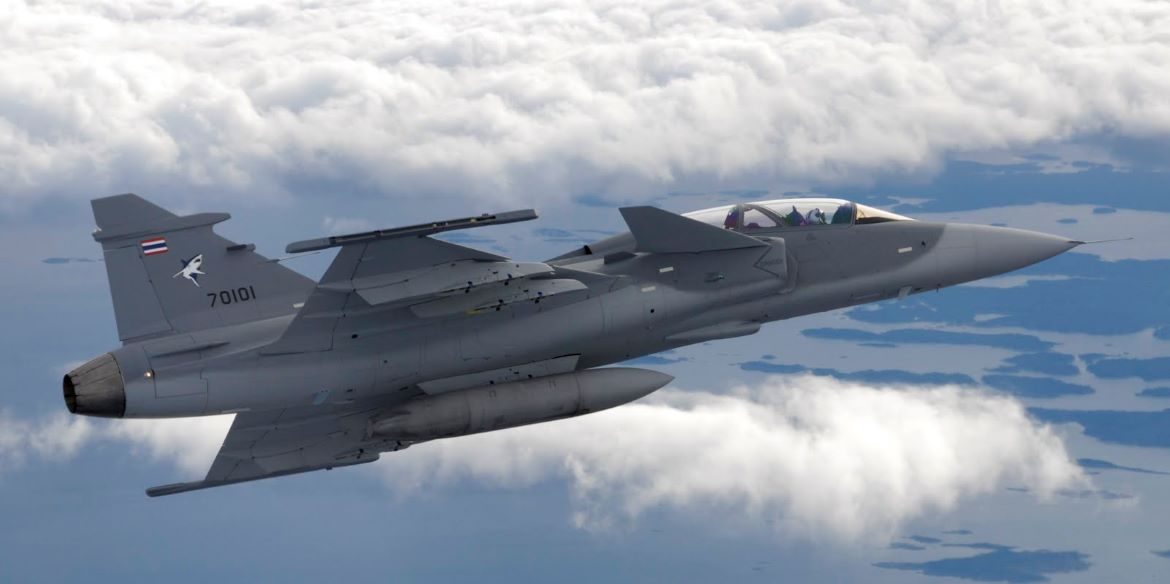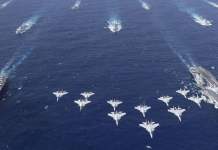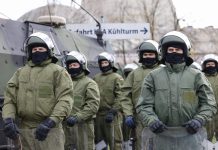As the joint aerial drills ‘Falcon Strike-2024’ between the Chinese PLA Air Force (PLAAF) and the Royal Thai Air Force (RTAF) got underway on August 18, analysts speculated that the PLAAF J-10C fighter jets might engage the Thai Gripens, years after SAAB warplanes decimated Chinese J-11 in similar drills conducted in 2015.
Chinese media reported that the PLA forces participating in the Falcon Strike-2024 joint air force training exercise touched down at the Udorn Royal Thai Air Force Base on August 16. The Royal Thai Air Force (RTAF) announced that the drills will be conducted between August 18 and August 29.
The Falcon Strike-2024 is the seventh iteration of the joint training drills between the Chinese and Thai air forces. The Chinese media report noted that the PLAAF has dispatched various military aircraft, including the J-10C fighter jet, the J-10S fighter jet, the JH-7A fighter bomber, and the Y-20 big transport aircraft.
Chinese military aviation specialist Fu Qianshao, who spoke to the Global Times, anticipated the two air forces would conduct ‘confrontational’ wargames. Fu said that the RTAF would likely deploy the SAAB Gripen fighters.
These claims could not be independently verified due to insufficient official information from either side. However, EurAsian Times understands that China deployed its cutting-edge military aircraft, including the J-10C fighter jet, the JH-7A fighter bomber, the J-11B fighter jet, and the KJ-500 early warning aircraft, in the 2023 iteration of Falcon Strike aerial drills.
The Y-20 and J-10 aircraft have arrived at the Royal Thai Air Force Base for the annual joint air force drill known as Falcon Strike 2024. This exercise, which will take place from August 18 to 29, aims to enhance the combat skills and cooperation between the Chinese and Thai air… pic.twitter.com/lF5Nhea9Aw
— China Perspective (@China_Fact) August 15, 2024
This year, the Chinese side has also sent helicopters, though the precise type was not disclosed. Analysts said the deployment of choppers during the joint drills made sense after the Defense Ministry announced that Chinese special operations personnel would be joining the drills. These troops are expected to simulate aerial attacks on strategic ground targets such as airfields, air defense sites, and command centers.
The Chinese Defense Ministry said the exercise aimed to promote pragmatic exchanges and cooperation between the military of the two states and improve the tactical levels and skills of their personnel.
Earlier, some Chinese analysts suggested that Thailand’s combat strategies, which are influenced by Western models and often involve aircraft developed by Western countries, could be valuable additions to China’s internal training programs. In recent times, China has strengthened its engagement with allied nations, conducting training exercises with Western-origin aircraft that could offer valuable insights to its fighter pilots.
Although the J-10C has been deployed for these drills multiple times in the past, the recent deployment and potential combat drills against the Gripen assume significance when seen in the context of the assertions made by Chinese analysts.
The J-10C is a 4+ generation combat aircraft that has effectively become the mainstay of the PLAAF and is expected to feature prominently in any future combat involving Beijing.

The drills and the combat performance showcased by the Chinese J-10C against the Gripen are also expected to interest India, as the Chinese aircraft has emerged as the main challenger to the French-origin Rafale fighter jet operated by the Indian Air Force.
Earlier this year, China deployed its J-10 Vigorous Dragon fighters just 300 kilometers from the Indian base that is home to Rafale fighter jets. While the Chinese have a host of cutting-edge fighters in their arsenal, including the J-20 stealth jets, the J-10C has been flagged as a major irritant.
J-10s are the only fighters deployed on both sides of the Indian border with China and Pakistan.
More importantly, though, the deployment of the J-10C in the drills is significant to gauge its combat performance, given that the RTAF is deploying the Gripen, which “ripped apart” a different Chinese fighter jet in the previous iteration of the drills.
When Thai Gripens “Ripped Apart” PLAAF Jets
The first-ever joint exercise between the Chinese and Thai air forces, known as the Exercise Falcon Strike, took place at Korat Royal Thai Air Force Base for two weeks in mid-November 2015. The specifics of these exercises were made public in 2019.
While the Chinese PLAAF brought J-11s to the wargame, the Thai Air Force deployed Swedish Saab JAS-39C/D Gripens, though it also operates the American F-16s.
The J-11 is a fourth-generation twin-engine PLAAF fighter jet based on the Russian Su-27 Flanker. It was inducted into service in 1998.

In contrast, the Thai JAS 39 Gripen is a Swedish fourth-generation single-engine multirole fighter jet that took its first flight in 1988 and entered service in 1996. The RTAF operates a NATO-compatible C/D model with extended capabilities in terms of armament, electronics, etc. The aircraft can also be refueled mid-air.
As the details of the drills came to light, military specialists were astounded to learn that a 25-year-old fighter outclassed the comparatively younger Chinese J-11 aircraft, particularly in the beyond-visual-range (BVR) encounters.
During the week-long exercise, the Chinese jets underperformed, prompting many analysts to question China’s aerial capabilities. According to reports, the J-11s were equipped with infrared-guided short-range missiles called PL-8s, while the Thai Gripen was equipped with an internal gun and AIM-9 infrared-guided missiles for close-quarters combat.
During the first two days of the war game in the 2015 drills, the powerful J-11s shot down 16 Gripens in a visual-range battle with no losses.

However, in the days that followed, as the combat moved beyond visual range, the Gripen equipped with AIM-120 medium-range missiles outperformed the J-11. And, at the end of the drills, the JAS 39s had a four-to-one kill-to-loss ratio, having downed 41 Su-27s and lost only nine JAS 39s to the Chinese.
According to military analysts, Gripens performed better in terms of range than J-11s. About 88% of Thai kills were at a distance of at least 19 miles, whereas only 14% of Chinese kills happened at the same range. In addition, the Gripens recorded 10 kills at a distance greater than 31 miles, compared to the J-11s’ zero-kill total. Moreover, the situational awareness of PLAAF pilots was found to be inadequate, according to the Aviation website Alert 5.
At that time, the struggle of Chinese jets against the fourth-generation Gripens thrilled Indian military analysts, who predicted that the induction of Rafale fighters would allow India to have a decisive edge over the PLAAF.
However, almost a decade has passed since this debacle and the PLAAF has seen a massive jump in terms of combat capability during this period. The country boasts a diverse fleet of aircraft, including the J-20 fifth-generation stealth fighters and the J-10C 4.5th-generation fighters, along with an array of capable and upgraded 4th-generation aircraft.
The J-10C, for one, is an advanced aircraft often compared to upgraded variants of the American F-16 Fighting Falcon. Like the F-16, the J-10 boasts a highly agile, aerodynamically unstable airframe, which is stabilized by a computer in its fly-by-wire flight control system. Its capabilities include beyond-visual-range engagement, precision air-to-ground strike, digital glass cockpit instruments, in-flight refueling, and electronic warfare.
The J-10C is significantly more advanced than the J-11, which faced a humiliating defeat against the Thai Gripens.
- Contact the author at sakshi.tiwari9555 (at) gmail.com
- Follow EurAsian Times on Google News




